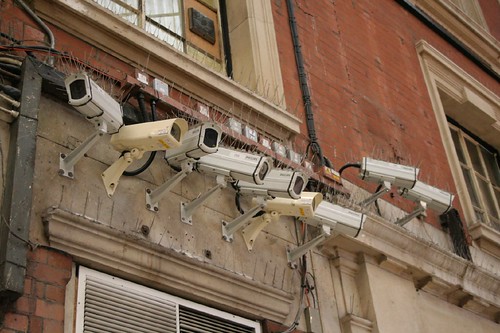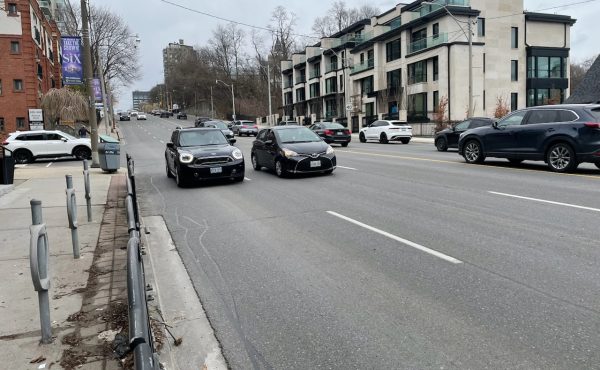
In Toronto and much of Canada, the introduction of CCTV by police to monitor public space is still in its infancy, passionately supported in some quarters, denounced by others, with the rest either indifferent or (myself included) not yet in possession of a fully formed opinion. In the UK, however, CCTV is a ubiquitous part of life and London’s Metropolitian Police are looking into taking its use to an even higher level by using video software — designed by a firm called “OmniPerception” — that can pick out suspects based on what they are wearing. The technology can “see” specific brands in a crowd and is currently used to identify company logos in TV broadcasts of sporting events to check the prominence of brand images. From the BBC:
Police believe that tracking suspects by their distinctive clothes will help cut down on the manual scanning of hundreds of hours of video footage.
—
The concept is being considered by Detective Chief Inspector Mick Neville of Operation Javelin, who project manages the Visual Images, Identifications and Detections Office roll-out programme: a pioneering effort to turn the analysis of CCTV into a forensic discipline like fingerprint or DNA analysis.
—
The software would allow officers to quickly analyse hours of CCTV footage, in which the suspect may have appeared, for images containing the distinctive clothing, in the hope of finding pictures that would enable police to make an identification.“The one thing most of these young criminals are clever enough to realise is that they should not go smiling at the camera,” said Mr. [David] McIntosh [OmniPerception’s CEO].
“What they do is they tend to go out in a kind of uniform, if you see a kid in a brand of “hoodie” you can be pretty sure he’ll be wearing that same brand of “hoodie” the next time he commits an offence.”
Though the use of this technology would seem to invite similar controversy as traditional police profiling does, there does appear to be potential for the policing of fashion crimes (oversized Dolce & Gabanna belt buckles and too-busy Gucci sweaters beware).
Photo of CCTV cameras at Victoria Station by Antonio Martinez.


8 comments
Sounds like a method incredibly prone to error. I hope they don’t put too much stock in it…
Interesting. This could be the beginning of a new chapter in No Logo about what happens when a brand becomes linked to criminal activity and/or “undesirable behaviour” in the public consciousness, and what happens when sporting a brand can make you vulnerable to police scrutiny. It could potentially shift the whole way we think about branding on clothing. It will be interesting to see how corporate entities/marketers and various segments of the public (parents, kids, schools, politicians, etc.) respond if this policing strategy becomes popular.
melissa> Indeed, when you watch some music videos (I noticed this first with hip hop videos a few years ago) the brand on hats and shirts is often fuzzed out. I think in the film Borat they did this too.
—
Similarly, a few years ago there were rumours that Burberry discontinued their familiar plaid caps because they became synonymous with (apologies) Chav culture in the UK:
http://www.murketing.com/journal/?p=632
and (read in particular the “commercial effect” section):
http://en.wikipedia.org/wiki/Chav
I find the use of “hoodie” here hilarious. I keep picturing the CEO pausing and making giant quotation marks with his fingers. Who knows what he REALLY means?
Haha, well Gloria, hoodie has become a derogatory name for a young person who wears hoodies, which is hilarious because designer hooded sweatshirts are becoming ever more popular in Canada and US, while they are “the clothes of a criminal” in the UK.
In many UK establishments and even malls, there are rules against wearing your hood up while inside.
Still against CCTV.
Nevermind the criminal element, hoodies just make people look like shapeless blobs.
/rant
Never mind hoodies, many Wetherspoons pubs ban hats to aid filming of customers. I was recently in the Wetherspoons in Uxbridge, on the outskirts of London, at 9am to get some breakfast and I had to remove my (flat) cap before they’d serve me a cup of tea and a morning roll!
The rules behind bans on hooded tops have been explicitly stated to be to ensure everyone gets filmed in malls, yet – I believe – the rise in popularity of hoodies is directly linked to the ubiquity of CCTV in the UK.
The clothing or fashion market is a multi-billion-pound industry and the constantly changing styles that dominate it are largely dictated by well-known designers who showcase their new seasonal collections several times a year at fashion shows in cities such as New York, London and Paris so because it is something I am interested in I thought I would try my luck at getting a piece of the action and wright some fashion fashion blogs – so I hope you don’t mind that I am scouring the net to get some idea’s from other peoples blogs to see exactly whats hot and not, yours has giving me a few tips for it, Thanks